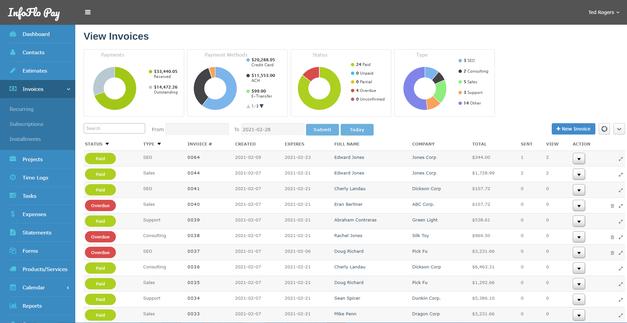Invoicing Management System
Introduction
Under the catalysis of information technology, the transformation of the world economy has entered a historical stage. The integration of the world economy, the globalization of business operations, and the highly personalized and rapidly changing customer needs caused by high competition have made the relationship between companies and customers, companies and suppliers closer and more dependent. Strengthening management, fine management, standardizing business processes, improving transparency, improving management quality, accelerating commodity capital turnover, and laying the foundation for a comprehensive network of information management in the circulation field are the dream desires of small and medium-sized enterprises and many businesses.
Small and medium-sized enterprises have a pivotal position in my country’s economic development. It is understood that my country’s small and medium-sized enterprises have a large number of small and medium-sized enterprises, widely distributed in regions, and a large span of industry distribution. With the development of global economic integration and China’s accession to the WTO SMEs will face severe challenges from foreign-funded enterprises and foreign products and services. In comparison, foreign-funded enterprises have stronger financial strength, rich management experience and advanced technical means. Therefore, if my country’s SMEs do not rely on advanced It will be difficult to win in the future international competition by changing the management concept of management and using informatization to improve the management level and work efficiency of the enterprise. However, enterprise management must be done with the help of informatization in many aspects to a large extent. The informatization level of my country's small and medium-sized enterprises is still very low. Compared with foreign-funded enterprises, it is still in its infancy. This requires us to make great efforts to build Good management of our business.
Manual management
Generally speaking, the collection of cost data in the financial department relies on manual operation, and the exchange of cost data between departments is carried out on paper media. Cost data cannot be exchanged. Statistics, analysis, and query.
It is understood that a common phenomenon faced by small and medium-sized enterprises in project cost accounting is the irregular operation process, which causes hidden dangers for enterprises.
In the past, due to relatively backward cost management methods, there was a lack of "quantitative" analysis of cost objects (generally only qualitative analysis) in decision-making, making decision-making often rely on the accumulation of personal experience of managers.
General functions
General functions of the invoicing management system:
1, support wholesale sales and retail sales;
2, supply Cargo merchant account management;
3, customer account management;
4, support sales exchange;
5, provide salesmen and employees Management;
6, provide POS-side sales management;
7, support financial management functions;
8, support inventory counting functions, and support counting machines;
9. Support chain store functions.
Daily maintenance
1. Back up your data frequently and store the backup files on a safe disk.
2, you must carefully consider when restoring data, because it will overwrite the existing data.
3. If you need to reinstall SqlServer2000, make sure to make a backup before uninstalling the database.
4. If you need to reinstall the operating system, please back up your data before installation.
5. When your Secret Invoicing software is accidentally damaged and cannot log in or the data is not backed up, please copy the Data file in the installation directory of SqlServer2000 and use it as a backup file.
System introduction
The purchase, sales and inventory management system is the circulation system of an enterprise and the material basis of the entire enterprise's production and operation activities. The production and operation activities of an enterprise, from the purchase of materials, the production and processing of products to the sales of products, etc., are, in a sense, a process of material conversion and flow. The operation and efficiency of the purchase, sale and inventory management system directly affects the economic benefits of the enterprise. From the perspective of the entire enterprise logistics, Xiaoyiwang realized the integration of inventory, procurement and sales logistics, and integrated with production, financial and other subsystems. The invoicing management system helps enterprises to rationally allocate logistics resources, dynamically control the flow of goods, effectively guarantee the supply of production and operation activities, reduce the occupation of inventory funds, improve the efficiency of goods turnover, reduce procurement and sales costs, and create good economic benefits for the enterprise.
The inventory management system includes three subsystems: inventory management, purchase management, and sales management.
Inventory management
The warehouse is the distribution node of enterprise logistics and the basis of item collection, statistics and accounting. The inventory management subsystem performs comprehensive control and management of the enterprise's logistics through operations such as inventory entry, exit, movement and inventory, so as to reduce inventory, reduce capital occupation, eliminate material backlogs and shortages, and improve customer service levels , To ensure the smooth progress of production and business activities. The warehouse of Xiaoyiwang includes all the distribution nodes of enterprise logistics, such as: material warehouse, auxiliary material warehouse, hardware warehouse, spare parts warehouse, finished product warehouse, semi-finished product warehouse and so on.
The inventory management subsystem manages the number of inventory items from different perspectives such as location, batch, and single item, so that users can understand and control the accurate situation and data of all aspects of inventory business in time. The inventory management subsystem is a multi-level management system that can reflect the inventory status of items from a variety of angles. The system can track the source and whereabouts of items. So that when problems are found in each link of sales and production, the cause can be investigated in time or the products that have problems can be recovered in time to minimize losses. The system can also perform automatic calculation of the order quantity of inventory items, alarms of various abnormal states, etc. The system supports automatic conversion of multiple measurement units and multiple currencies.
The inventory management subsystem has realized data integration with the procurement, sales, production and other subsystems. The business data of these subsystems, such as purchase receipt, production picking list, sales delivery note, etc. Directly generate inbound and outbound orders without manual entry, maintaining data consistency.
Xiaoyiwang can define inventory operation reasons for each warehouse and classify different inventory operations to simplify the complexity of inventory activities, simplify the statistics of inventory items, and facilitate the integration with other subsystems.
Main functions
1. Support batch and single-piece inventory management methods.
2. Provides a variety of customization reasons for inventory operations.
3. Provides automatic conversion between a variety of measurement units.

4. Support dual measurement unit management, and can be flexibly configured.
5. The maximum inventory and safety inventory can be set for items, and there are over-limit alarm processing and item backlog and shortage statistics.
6. Record the inventory history and query the quantity of items in each stage in the past.
7. Support freeze inventory and cycle inventory methods.
8. Provide adjustment processing of inventory profit and inventory loss, and generate inventory record accuracy reports.
9. Provide year-end and month-end settlement processing.
10. Save inventory operation records and query historical data of inventory operations in the past.
11. There is an order point alarm function, and the order point and order date can be automatically calculated according to the past article consumption law and other parameters to generate a requisition plan.
12. There are horizontal and vertical inventory operation authority checks to ensure data security.
13. Provide tracking of the source and destination of items so that problems can be found and the cause can be investigated in time and the problematic items can be recovered to reduce further impact and loss.
Purchasing management
Purchasing management occupies a very important position in the production and operation of enterprises. Any company that wants to provide products or services to the market cannot do without the purchase of raw materials and consumables. Especially for manufacturing companies, material costs account for a particularly large proportion of the entire product cost. Strengthen procurement management, complete procurement tasks in a timely, appropriate quantity, quality, and cost-effective manner, ensure the supply of materials required for production and operation, reduce procurement costs and improve the quality of procurement operations have become the goals pursued by every enterprise.
The procurement management subsystem manages and controls the entire process of purchase plan, purchase order release, purchase order signing, execution, tracking, arrival receiving, inspection and storage. The system comprehensively manages suppliers’ quotations, delivery dates, product quality, and contract fulfillment rates, and helps purchasers choose the best suppliers and purchasing strategies to ensure high-quality, high-efficiency, and low-cost execution of the procurement work. The system also strictly controls the purchasing authority, scope and approval authority of the purchaser.
The procurement management subsystem has realized data integration with the production, inventory, accounts payable management and cost management subsystems. Purchasing demand information can be directly issued by other departments such as production, inventory, etc., without manually entering the purchase order, as long as the requisition items are combined and released, the purchase order can be generated conveniently and flexibly; the purchased items can be based on the allocated inventory after the receipt inspection The location is automatically stored in the warehouse and the inventory is updated in time; at the same time, the cost and accounts payable subsystem completes the carry-forward of purchase costs and payables, without the need for financial personnel to manually fill in vouchers.
The system supports multi-currency purchases.
Main functions
1. Supplier quotation management.
2. Supplier file management.
3. Requisition management. Purchase requisitions are generated by production or warehouse, and can also be entered manually; split/merge of purchase requisitions; confirmation of purchase requisitions.
4. Purchase order management. Including order entry/maintenance, issuance, settlement, termination and recycling. Only orders that have been issued can be processed for receipt; if all orders have been received, the system can clear them automatically or manually; orders that have been received can be terminated after verification; orders that have not been received can be recycled deal with.
5. Receiving management. The item receipt registration can be received according to the purchase order, or it can be entered directly. Then allocate warehouses and storage locations to the received goods. After the receipt is confirmed, the warehouse receipt is generated directly. Receiving management supports batch and single piece management.
6. return the goods. Items that have been received can be returned. The return can be entered according to the receipt or manually. After the return order is confirmed, the warehouse receipt order (the receipt quantity is a negative number) will be generated directly.
7. Checkout processing. The system provides monthly checkout function. In the final accounting period, the corresponding data is transferred to the historical data.
8. Inquiries about various procurement operations.
Sales management
Sales management is the window for enterprises to face the market. The main function is to provide customers with products and services, realize the transformation of corporate funds and obtain profits, so as to realize the social value of the company and provide motivation for the survival and development of the company. In the current environment of increasing market economy, sales management is particularly important for every enterprise.
The sales management subsystem of Xiaoyiwang Invoicing Management System is an application software system for sales management of various domestic industrial and commercial enterprises. It adopts foreign advanced management ideas in the design, and manages the entire sales business with orders (contracts) as the core. It is a multi-step, continuous-step system, including customer file management, sales quotation, sales plan formulation, sales order management, combined order management, customer credit check, customer receipt management, bill of lading and sales pickup processing, sales invoices and redemption A series of sales management affairs such as invoice processing, customer return, payment rejection processing, etc. Through this system, companies can learn about market demand, product orders, sales and profitability in a timely manner, and provide timely and accurate market information for the company's production and operation.
The sales management subsystem is closely related to the inventory, finance, production and other subsystems, and together they form a complete enterprise management information system. This system helps to improve the enterprise's customer service level, strengthen the enterprise's market adaptability, and ensure that the enterprise can always be in an advantageous position in the competition.
Main functions
1. Sales plan management.
2. Sales order management. Including entry/maintenance, confirmation and order suspension.
3. Support combination order management.
4. Sales and delivery management. Including invoice entry/maintenance, invoice review, invoice pickup and delivery processing, invoice settlement, invoice termination, return order entry/maintenance, return order review, return storage processing, and customer signature management .
5. Invoice management. Including sales invoice entry, sales invoice confirmation, invoice distribution to invoice, invoice refusal, etc.
6. Checkout processing. The system provides monthly checkout function. In the final accounting period, the corresponding data is transferred to the historical data.
7. Sales expense management.
8. Sales policy management.
9. Query statistics and various reports.
Application software
The development of invoicing management software is born with the needs of enterprise information development. A useful invoicing software can help companies better Development, but as far as the status quo is concerned, many companies do not have a good understanding of the importance of implementing invoicing management, and even some have already implemented invoicing management and feel that the implementation effect of invoicing software is not so obvious. Why is this? In fact, this is because the application depth and breadth are not in place. Invoicing management software is the embodiment of the new management model. If it is applied well, it will have a subversive revolution to the old management model. Significance, to bring a better tomorrow for enterprises, after the launch of Weidian plus Invoicing, it may change all of this.
Potential value
Farewell to manual bookkeeping and bid farewell to the era of manual bookkeeping. Print out neat and beautiful delivery notes. This is related to the company’s image and the company’s internal management. Because this way the company's accounts will be clearer.
Data sharingData can be shared, you can check your own business conditions at any time, and all related queries and statistical systems can be completed in an instant.
One-click query of accounts The accounts are clear and easy to query. If you are a boss, you can use the software to query various data of the company at any time with one-click statistics.
Cost saving save labor cost and improve work efficiency. Because employees can work in a standardized software environment, the company's business and management are streamlined and institutionalized, and the management level will rise to a higher level.
Quickly check inventory For various inventory queries of customers' products, the speed of response can be improved. For example, if a customer asks if 200 pieces of a certain product can be supplied, you can check it on your computer. You can also immediately know what the price was last sold to this customer and how many orders the customer placed last time.
Easy to print The company’s accounts will be very clear. At the end of the month, you can reconcile and collect accounts with customers as long as you print out each customer’s monthly statement.
Check inventory status If the company has just received an order, it can be completed according to the order
Latest: The First Affiliated High School of Central China Normal University
Next: Jiangyin naval battle








